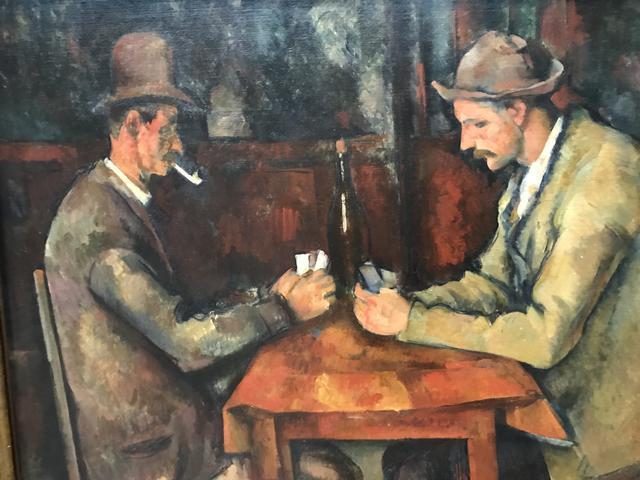Card players

The Card Players by Paul Cézanne is a masterpiece that is part of a series of five paintings depicting a card game, created between 1890 and 1895. This particular painting is an oil on canvas with dimensions of 47.5 cm x 57 cm, showcasing Cézanne's unique style and artistic vision. Inspired by the works of Le Nain and Chardin, Cézanne delved into the theme of card players with a fresh perspective that would later solidify his reputation as the father of modern painting.
The series culminates in the last two paintings, featuring two peasants engrossed in a game of cards. The lack of expression on their faces is a striking departure from traditional portraiture, marking a significant shift towards post-impressionism. Cézanne's rejection of the vibrant colors favored by the Impressionists in favor of a more subdued palette highlights his commitment to exploring form, volume, and shape over light and color.
As one of the most renowned works of post-impressionism, The Card Players invites viewers to witness a silent yet intense confrontation between the players. Cézanne's meticulous attention to detail and composition creates a sense of tension and drama within the seemingly mundane setting of a card game. The painting serves as a window into the world of these expressionless characters, inviting us to contemplate the complexities of human interaction and emotion.
Cézanne's departure from the Impressionist style is evident in The Card Players, as he prioritizes form and structure over fleeting impressions of light and color. His deliberate choice to depict the players in a state of concentration and detachment adds a layer of mystery to the scene, inviting viewers to interpret the narrative behind the silent exchange. Through this painting, Cézanne challenges conventional artistic norms and invites us to reconsider the boundaries of representation and expression in art.
In conclusion, The Card Players stands as a testament to Cézanne's innovative approach to painting and his enduring influence on the development of modern art. This iconic work continues to captivate audiences with its enigmatic portrayal of human interaction and its timeless exploration of form and composition. Whether you are a seasoned art enthusiast or a curious traveler, a visit to see The Card Players is sure to leave a lasting impression and spark contemplation on the power of visual storytelling.
© ChatGPT 3.5
The protagonists of this painting are two peasants, from Aix, and the gardener of the Jas de Bouffan, Vallier. Some people believe that Cézanne was trying to depict his constant struggle with his father.
Cézanne also made a smaller version of 32 x 35 cm in which a single player is seen frontally that belongs to the Worcester Art Museum in Massachusetts USA. At the beginning of 2012, one of the paintings in this series became the most expensive painting in history with a value of 250 million dollars. This amount was paid by the Qatari royal family to the family of Yorgos Embiricos, although in 2015 a painting by Gauguin ended up surpassing this record.
Let us remember that Cézanne never had a revolutionary mind; he relied on his previous knowledge, especially his love for the classics, to conceive a new artistic language.
Cézanne was isolated by several of his contemporaries because he gradually separated from the Impressionists, therefore he was not as recognized after his death, his appreciation really began when artists of the stature of Picasso or Braque began to praise him and say How much influence he had on them, especially Picasso, since Cézanne was considered by many to be the precursor of the Cubist style.